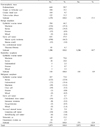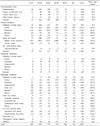Abstract
Objective
The aim of this study was to know the clinicopathological characteristics that help to make a decision about diagnosis and treatment of ovarian masses in Korean women.
Methods
Women who were undergone operations and histopathologically confirmed as ovarian masses at Inje University Busan Paik Hospital and Donrae Paik Hospital from January of 1997 to June of 2009 were enrolled in this study. Distribution according to histopathological types and ages were analyzed.
Results
Of the 2875 cases, there were 1078 cases (37.5%) of non neoplastic masses and 1797 cases (62.5%) of neoplastic masses. In the neoplatic masses, there were 1286 cases (44.7%) of benign tumors, 140 cases (4.9%) of borderline tumors and 371 cases (12.9%) of malignant tumors. Endometriomas were most common tumors (644 cases, 59.7%) among non-neoplastic masses. Mature cystic teratomas were the most common tumors (598 cases, 46.5%) among benign tumors. Mucinous cystadenomas were the most common types (105 cases, 75.0%) among borderline tumors. Epithelial ovarian cancers were the most common types (267 cases, 72.0%) among malignant tumors. As the result of age distribution, mature cystic teratomas were the most common types of the women of the first and second decade, endometriomas were the most common types of the women of the third and fourth decade, and benign epithelial tumors were the most common types of the women of fifth and after sixth decade.
Figures and Tables
References
1. Levi F, Lucchini F, Negri E, Boyle P, La Vecchia C. Cancer mortality in Europe, 1995-1999, and an overview of trends since 1960. Int J Cancer. 2004. 110:155–169.

7. Shin HR, Jung KW, Won YJ, Park JG. 139 KCCR-affiliated Hospitals. 2002 Annual report of the Korean Center Cancer Registry: Based on Registered Data from 139 Hospitals. Cancer Res Treat. 2004. 36:103–114.
16. Yokoyama Y, Moriya T, Takano T, Shoji T, Takahashi O, Nakahara K, et al. Clinical outcome and risk factors for recurrence in borderline ovarian tumours. Br J Cancer. 2006. 94:1586–1591.

23. Kozlowski KJ. Ovarian masses. Adolesc Med. 1999. 10:337–350. vii.
24. Koonings PP, Campbell K, Mishell DR Jr, Grimes DA. Relative frequency of primary ovarian neoplasms: a 10-year review. Obstet Gynecol. 1989. 74:921–926.

25. Seidman JD, Kurman RJ. Subclassification of serous borderline tumors of the ovary into benign and malignant types. A clinicopathologic study fo 65 advaced stage cases. Am J Surg Pathol. 1996. 20:1331–1345.




 PDF
PDF ePub
ePub Citation
Citation Print
Print





 XML Download
XML Download